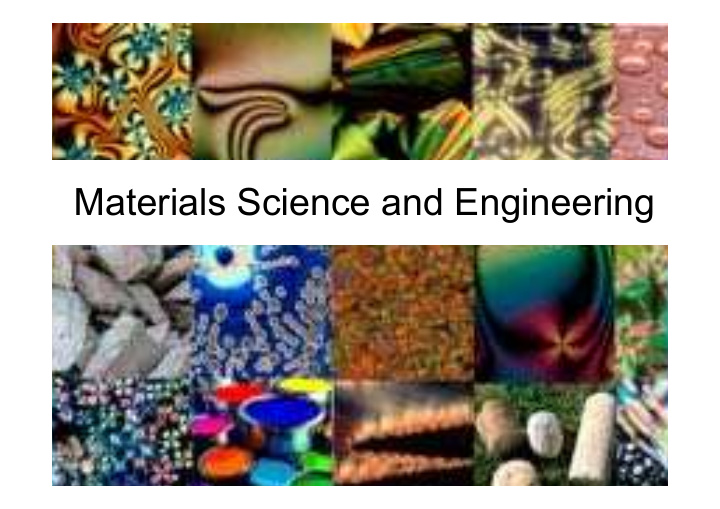



MESA + Institute for Nanotechnology Materials Science and Engineering
Silicon Solar Cell Efficiency Record Aprill 2017 25.8 %
Solar Cell Efficiency World Record December 1, 2014 46.0 % Organic Solar Cell Efficiency Record January, 2015 11.5 %
World record perovskite solar cell Korea Research Institute of Chemical Technology (KRICT) Dr. Sang Il Seok 22.7 % July 2017
Introduction: What is Materials Science and Engineering? Function Properties Structure Synthesis Structure Materials Science Functionality in application Toplayer: • Transparent • Electrically conducting • Mechanically strong • Chemically stable
Advanced Materials Science & Engineering Course Objective... Introduce fundamental concepts in Materials Science You will learn about: • how structure dictates properties • how synthesis controls structure This course will help you to: • use and choose materials properly • realize new design opportunities
Introduction: What is Materials Science and Engineering? Fundamentals of solids Structure Chem. and Tech. Advanced of Materials Materials Materials Science Application focus Physics track Chemistry track or
Materials Science and Engineering AT – module 6 Course “Fundamentals of solids” Exam Course “Advanced Materials” Exam on relation structure-property Course “Chemistry and Technology of Materials” Report on relation synthesis-structure Groups of 4 students: Exam Case study on a specific material application
AT - Case study topics Group 1 – Cancer detector For many diseases it is very important to detect them in an early stage, so they can still be treated successfully. A person’s breath can contain small particles, which indicate the possible presence of lung cancer. Sensors are being developed to perform such early stage diagnostic in which the sensitivity of a piezoelectric element is crucial. A promising material is lead zirconate titanate ( PZT ). Group 2 – Self-cleaning surgical tool Environmental disinfection plays a crucial role in the prevention of infectious diseases. In hospitals anti-bacterial treatment is a very crucial procedure to keep everything sterile. Self- cleaning surfaces on surgical tools are formed by coating with a photocatalytic material. A promising material is TiO 2 . Group 3 – Hydrogen fuel cell car Hydrogen fuel cell cars are zero emission and run on compressed hydrogen fed into a fuel cell stack that produces electricity to power the vehicle. Solid oxide fuel cells use high tech ceramics as the electrolyte, which enhances efficiency and stability but presents a challenge in terms of temperature. A promising material is YSZ . Group 4 – Microbattery for medical implant Common rechargeable batteries are based on a liquid electrolyte, which implies that there are several restrictions for their design and size. Secondly, they carry the inherent risk of leakage. Therefore, the need for all-solid-state microbatteries arises, which can facilitate miniaturization, will create more flexibility for the design of standalone microelectronic devices and enhance their applicability, for example in medical implants, due to the avoided leakage risks. A promising material is LiCoO 2 .
Rechargeable batteries
Lithium technology
Implantable medical devices Wireless sensors On-chip energy management Wearable electronics
Solid-state batteries
Materials Science and Engineering AT – module 6 Course “Fundamentals of solids” Exam Course “Advanced Materials” Exam on relation structure-property Course “Chemistry and Technology of Materials” Report on relation synthesis-structure Groups of 4 students: Exam Case study on a specific material application Chemistry track Course “Physical Chemistry of Interfaces” Lab course 3 Tests Physics track Course “Semiconductor Devices” Exam Report
SUMMARY Course Goals: • Use the right material for the job. • Understand the relation between properties, structure, and synthesis. • Recognize new design opportunities offered by materials selection.
Recommend
More recommend